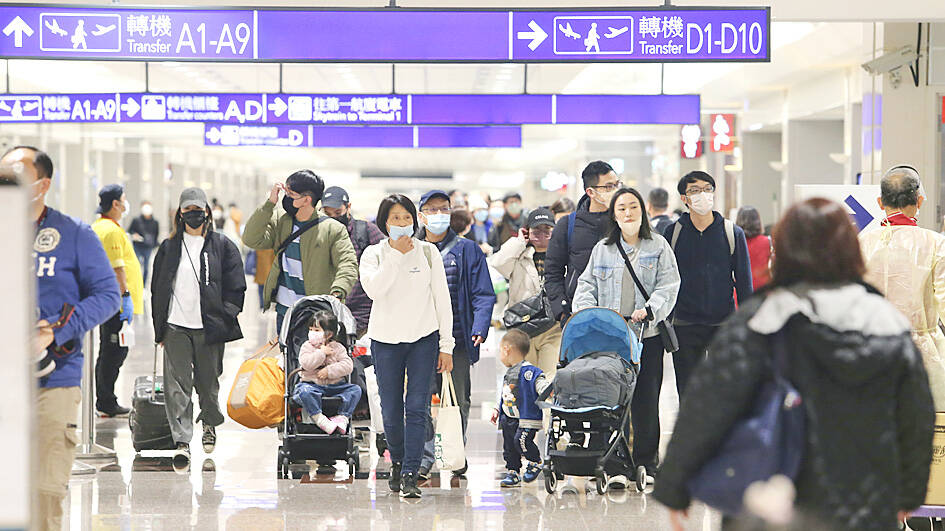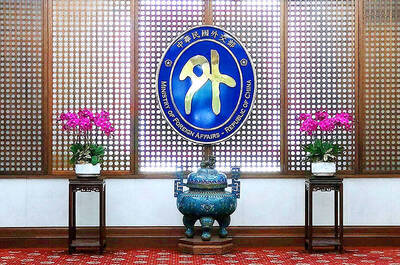The Executive Yuan yesterday approved a Tourism Bureau proposal to allocate NT$5.3 billion (US$174.31 million) from last year’s surplus tax revenue to attract international tourists in the next three years.
The bureau has funding to distribute the money — NT$5,000 each — to 500,000 international visitors, bureau Director-General Chang Shi-chung (張錫聰) told a news conference at the Ministry of Transportation and Communications in Taipei.
“The money will be given out through multiple tourism promotion events this year, rather than giving it all out at once,” Chang said. “As such, not all international tourists would receive it.“

Photo courtesy of Taiwan Taoyuan International Airport
“International tourists who are given NT$5,000 will not receive it until they arrive,” he said. “It will be stored in an electronic ticketing card, which can be used to pay for food, accommodation and other travel expenses during their time here.”
The bureau would also offer incentives for domestic and overseas travel agencies to bring international tourists to Taiwan, Chang said.
A tour group from overseas would receive a subsidy of NT$10,000 if it has eight to 14 members and NT$20,000 if it has more members, he said, adding that there was enough money for 90,000 groups.
To address staffing shortages in the hotel industry, the government would help pay the salaries of new hotel employees, he said.
“Hoteliers will receive a bonus of NT$5,000 per month for each new staff member they hire,” Chang said. “It will help raise the monthly salary of entry-level hotel employees in Taipei, Taoyuan, Hsinchu, Keelung and New Taipei City to NT$33,000 or more.”
“Hotel employees in other administrative regions would see their monthly salaries rise to or above NT$31,000,” he added.
The bonus could continue for up to one year, he said, adding that employers must not lower the salaries once the funding ends.
The bureau is planning to focus on attracting tourists from Japan, South Korea, Europe, North America and target countries of the New Southbound Policy, Chang said.
The 18 countries defined in the policy are: Australia, Bangladesh, Bhutan, Brunei, Cambodia, India, Indonesia, Laos, Malaysia, Myanmar, Nepal, New Zealand, Pakistan, the Philippines, Singapore, Sri Lanka, Thailand and Vietnam.
The goal is to attract 6 million international tourists this year, Chang said.
High-Quality of Travel Association chairman Ringo Lee (李奇嶽) said that the government should ensure that more sectors can benefit from the cash distribution to international tourists.
“The government should strive to have more international tourists visit central, southern and eastern Taiwan, not just the north,” Lee said.
While it is important to offer incentives for overseas travel agencies to organize tour groups to Taiwan, the government should also encourage them to stay in hotels and hire tour buses run by Taiwanese operators, he said.
“The number of Taiwanese traveling overseas has far exceeded the number of inbound tourists,” Lee said.
“Compared with nearby countries, we are relatively late in reopening the borders for international tourists and have fewer means to conduct international tourism marketing,” he added.
The government should also restart all cross-strait flight routes, which would boost inbound and outbound tours, he said.

The Ministry of Foreign Affairs (MOFA) yesterday voiced dissatisfaction with the Comprehensive and Progressive Agreement for Trans- Pacific Partnership (CPTPP), whose latest meeting, concluded earlier the same day, appeared not to address the country’s application. In a statement, MOFA said the CPTPP commission had "once again failed to fairly process Taiwan’s application," attributing the inaction to the bloc’s "succumbing to political pressure," without elaborating. Taiwan submitted its CPTPP application under the name "Separate Customs Territory of Taiwan, Penghu, Kinmen and Matsu" on Sept. 22, 2021 -- less than a week after China

THE GOOD WORD: More than 100 colleges on both sides of the Pacific will work together to bring students to Taiwan so they can learn Mandarin where it is spoken A total of 102 universities from Taiwan and the US are collaborating in a push to promote Taiwan as the first-choice place to learn Mandarin, with seven Mandarin learning centers stood up in the US to train and support teachers, the Foundation for International Cooperation in Higher Education of Taiwan (FICHET) said. At the annual convention of the American Council on the Teaching of Foreign Languages held over the weekend in New Orleans, Louisiana, a Taiwan Pavilion was jointly run by 17 representative teams from the FICHET, the Overseas Community Affairs Council, the Steering Committee for the Test of Proficiency-Huayu, the

A home-style restaurant opened by a Taiwanese woman in Quezon City in Metro Manila has been featured in the first-ever Michelin Guide honoring exceptional restaurants in the Philippines. The restaurant, Fong Wei Wu (豐味屋), was one of 74 eateries to receive a “Michelin Selected” honor in the guide, while one restaurant received two Michelin stars, eight received one star and 25 were awarded a “Bib Gourmand.” The guide, which was limited to restaurants in Metro Manila and Cebu, was published on Oct. 30. In an interview, Feng Wei Wu’s owner and chef, Linda, said that as a restaurateur in her 60s, receiving an

Kaohsiung Mayor Chen Chi-mai (陳其邁) on Monday announced light shows and themed traffic lights to welcome fans of South Korean pop group Twice to the port city. The group is to play Kaohsiung on Saturday as part of its “This Is For” world tour. It would be the group’s first performance in Taiwan since its debut 10 years ago. The all-female group consists of five South Koreans, three Japanese and Tainan’s Chou Tzu-yu (周子瑜), the first Taiwan-born and raised member of a South Korean girl group. To promote the group’s arrival, the city has been holding a series of events, including a pop-up